Earlier this week, I shared a newly expanded list of my top DO’s and DON’Ts when it comes to starting seeds. Today I thought I’d highlight a few of my favorite hardy annual flowers that can be sown early inside to get a jump start on the growing season.
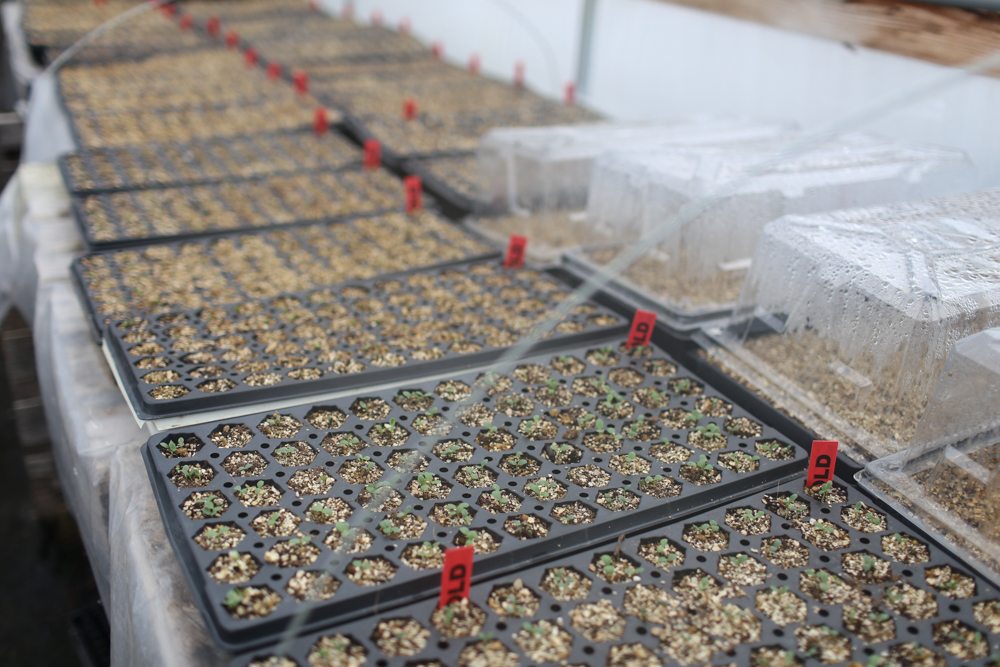 Among the many other benefits of transplanting plants that you started from seed indoors (versus direct seeding in your garden or field) is that it enables you to transplant strong, healthy plants exactly where you want them. Plus, established plants generally experience less pressure from weeds and pests.
Among the many other benefits of transplanting plants that you started from seed indoors (versus direct seeding in your garden or field) is that it enables you to transplant strong, healthy plants exactly where you want them. Plus, established plants generally experience less pressure from weeds and pests.
If you have access to a greenhouse or an indoor space where you can rig-up some simple grow lights, there are a number of flowers that you can start indoors. For many varieties, you won’t want to start seeds until 6-8 weeks prior to your last frost. (If you are not sure of your area’s frost-free dates, you can enter your zip on Dave’s Garden site which will provide you with an estimate).
There are a number of hardy annual flowers, however, that you can start indoors even earlier, which is great for gardeners itching to get their hands back in the dirt this time of year. Hardy annuals (also called cool season or cold tolerant flowers) generally prefer cooler growing conditions and young plants can tolerate a light frost. Most can be transplanted prior to your last frost, typically as soon as the ground can be worked. Just don’t forget to harden-off your baby plants prior to transplanting.
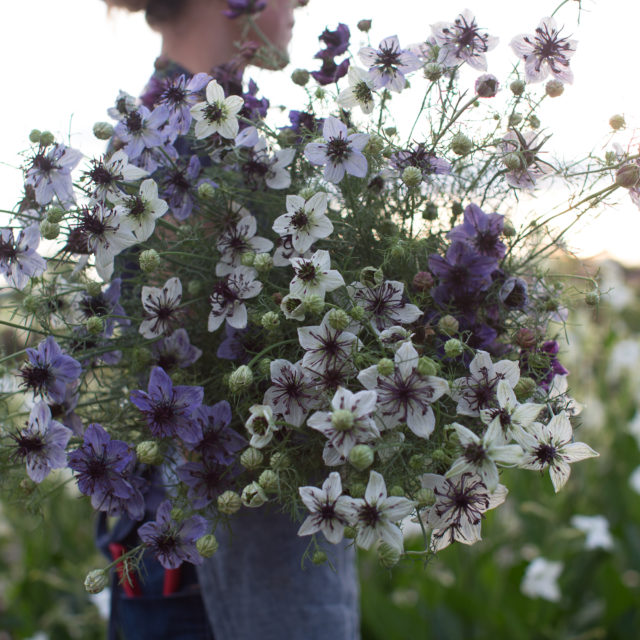
Love-in-a-Mist (Nigella papillosa): This versatile plant produces both beautiful flowers and unusual pods. Designers drool over the the black pods while I adore the green in mixed bouquets and arrangements. Pods can also be dried and look lovely in fall bouquets. Nigella seeds are most often direct seeded, as they dislike having their roots disturbed, but they can be started early indoors and carefully transplanted into your garden. Because their bloom window is relatively short, I recommend multiple succession sowings of these beauties. A few of my favorites are ‘African bride’ and ‘Cramer’s Plum’ and my Starry Night custom blend (pictured above). Another must-have for the cut flower garden is ‘Transformer’ which features airy, wispy foliage and small, golden yellow flowers.
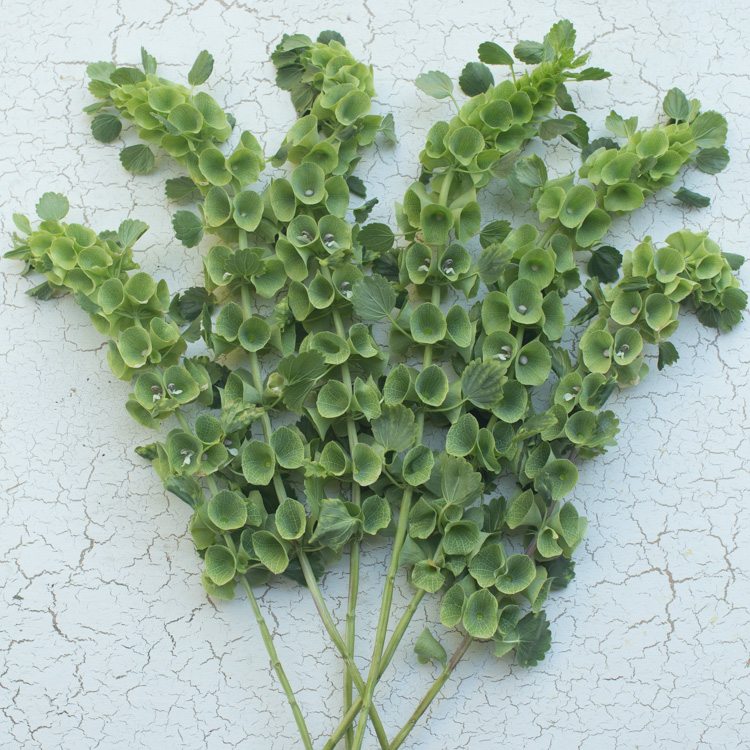 Bells of Ireland (Moluccella laevis): Each and every Bells of Ireland plant churns out masses of beautiful, fragrant stems that make bouquets look lush and vibrant. Bells of Ireland seeds have a reputation for being hard to germinate, but the key is providing a cold treatment. To grow, we pre-chill the seed in the freezer or put freshly sowed trays outside for a few weeks before returning them to the heat. I know some growers that have great success starting their Bells of Ireland by first placing their seeds on moistened paper towel in a ziplock bag and then they stick the seeds in the refrigerator for a few weeks before sowing them in trays. Whichever method you choose, germination can sometimes be slow and erratic, so be patient.
Bells of Ireland (Moluccella laevis): Each and every Bells of Ireland plant churns out masses of beautiful, fragrant stems that make bouquets look lush and vibrant. Bells of Ireland seeds have a reputation for being hard to germinate, but the key is providing a cold treatment. To grow, we pre-chill the seed in the freezer or put freshly sowed trays outside for a few weeks before returning them to the heat. I know some growers that have great success starting their Bells of Ireland by first placing their seeds on moistened paper towel in a ziplock bag and then they stick the seeds in the refrigerator for a few weeks before sowing them in trays. Whichever method you choose, germination can sometimes be slow and erratic, so be patient.
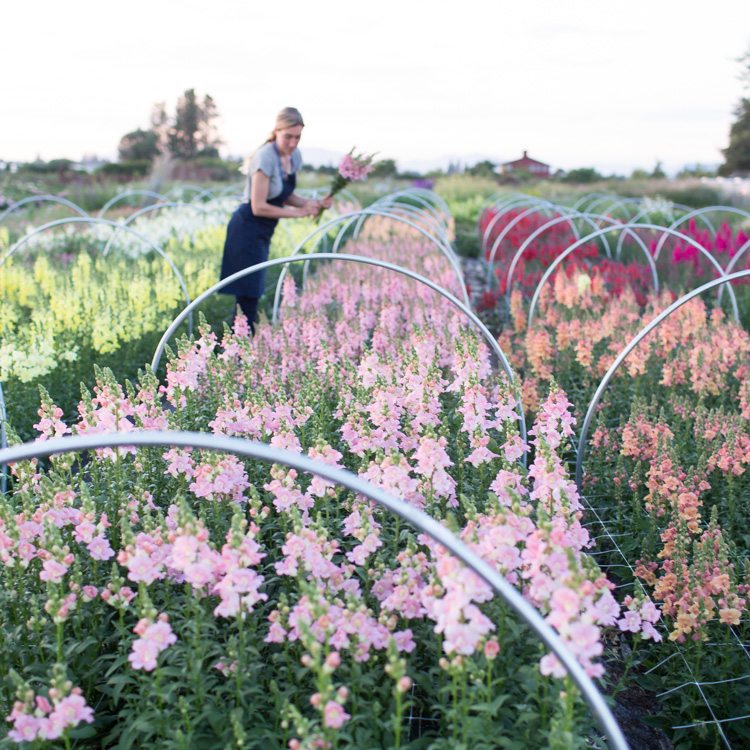 Snapdragons (Antirrhinum majus): For many years we would thousands of snapdragons for natural grocery stores and sell every useable stem in the patch! Madame Butterfly snapdragons are among my favorites. This gorgeous group of ruffled butterfly-type blooms is one of our most requested and best loved crops of the summer! Our buyers would always jump up and down clapping when the first bunches were delivered.
Snapdragons (Antirrhinum majus): For many years we would thousands of snapdragons for natural grocery stores and sell every useable stem in the patch! Madame Butterfly snapdragons are among my favorites. This gorgeous group of ruffled butterfly-type blooms is one of our most requested and best loved crops of the summer! Our buyers would always jump up and down clapping when the first bunches were delivered.
Snapdragon seeds are pretty easy to germinate and grow, but be forewarned: the seeds are teeny tiny and can make you feel like you are going crosseyed. Sowing them takes a steady hand and a bit of patience, but it is totally worth it when you see the pretty blooms later in the season. Be sure to barely cover them and water them from the bottom (see our Seed Starting 101 photo tutorial for more details) until they are big enough to withstand a heavier overhead drink.
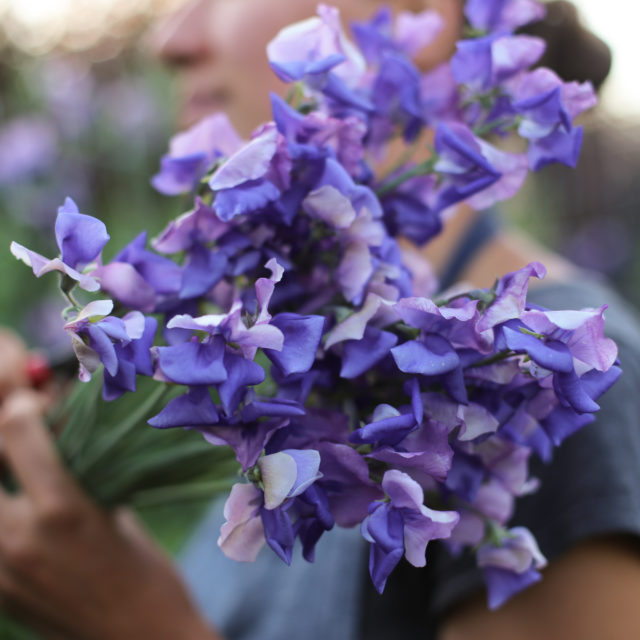
Sweet Peas: These sweet little blooms hold a huge space in my heart and an even bigger space in my garden. My longtime favorites have been ‘Nimbus,’ ‘Mollie Rilstone’ and ‘Erewhon’ (pictured above). After recently expanding our line of specialty sweet pea seeds, my favorites list has grown considerably. New cultivars that stole my heart include ‘Mr. P ‘, ‘Promise’ and ‘Sir Jimmy Shand’. A while back I wrote an in-depth Sweet Pea Roundup post with tons of information on how to grow sweet peas, so be sure to read it for some serious sweet pea inspiration.
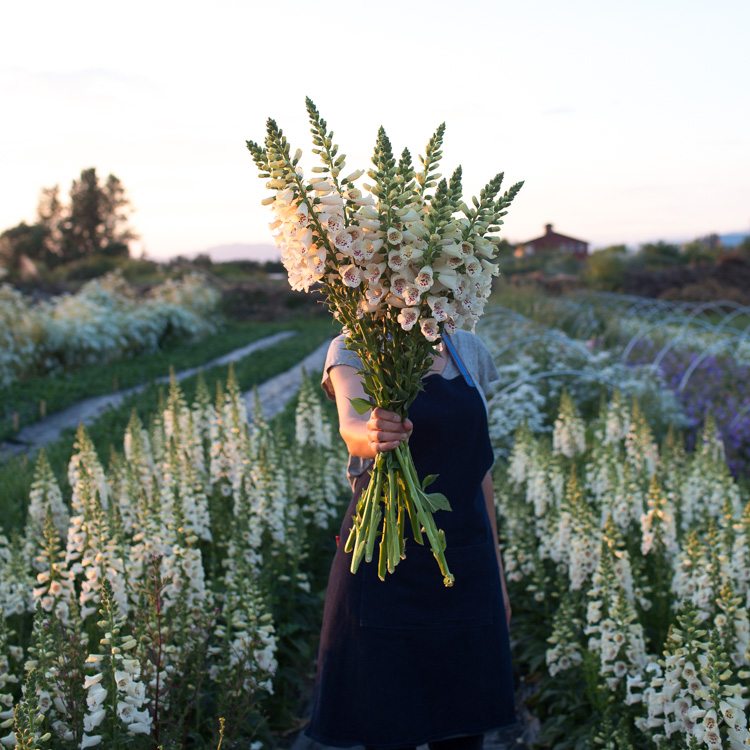 Foxglove (Digitalis purpurea): My two favorite foxgloves are Camelot Cream and Dalmation Peach and unlike biennials, these two cultivars will bloom without any cold which means they can be grown as an annual. Like snapdragons, foxglove seeds are tiny and can be washed away easily, so be sure to plant in pre-moistened seed starting or potting mix or bottom water to protect this precious seed.
Foxglove (Digitalis purpurea): My two favorite foxgloves are Camelot Cream and Dalmation Peach and unlike biennials, these two cultivars will bloom without any cold which means they can be grown as an annual. Like snapdragons, foxglove seeds are tiny and can be washed away easily, so be sure to plant in pre-moistened seed starting or potting mix or bottom water to protect this precious seed.
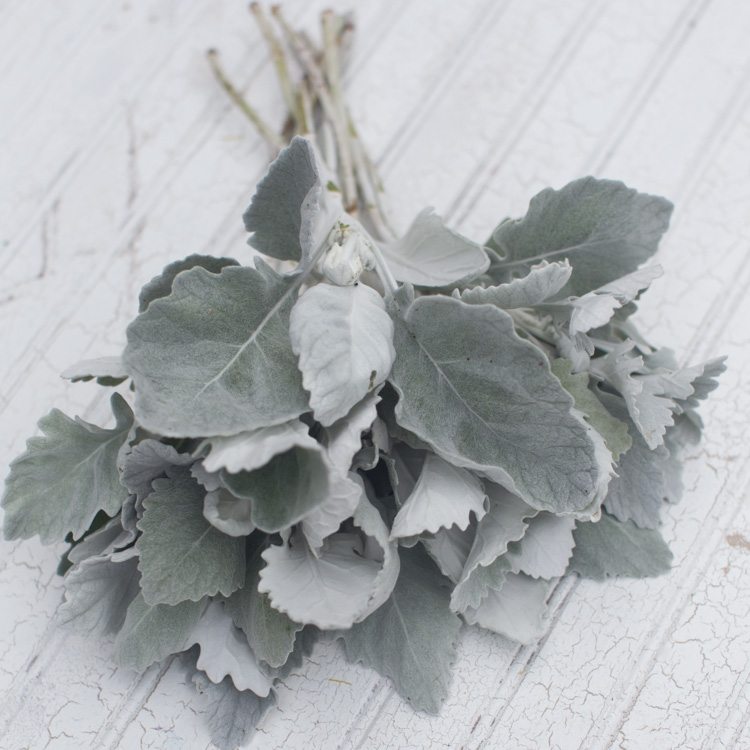
Dusty Miller (Cineraria maritima): One of the most productive and unique foliage plants around, this special Dusty Miller features tall, thick stems with large, smooth-edged silver leaves. Seed is sometimes slow to start; bottom watering is recommended until plants emerge. Seedlings do not look silver when very young but color up as they mature.
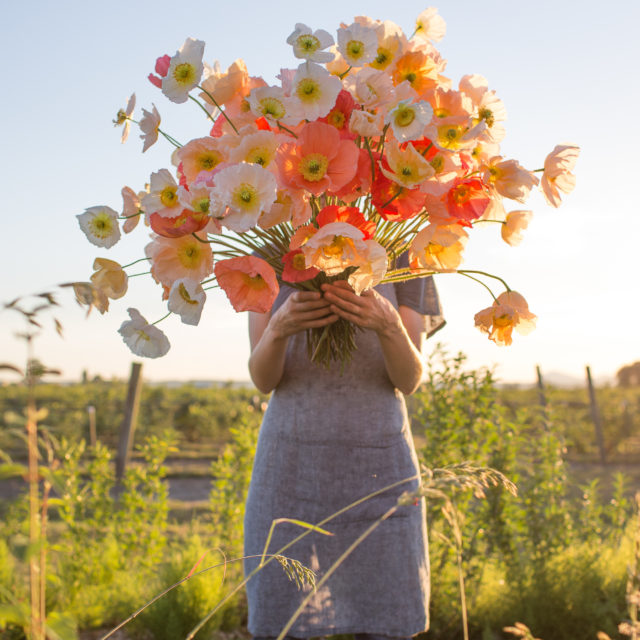 Iceland Poppies (Papaver nudicaule): The brilliant silk-like petals and citrusy scent of these beauties are intoxicating and they add a romantic element to any bouquet. There are lots of poppies to choose from, but some of my favorites include Champagne Bubbles, and Sherbet Mix. Poppy seed is tiny and can be washed away easily, so be sure to plant in pre-moistened seed starting or potting mix and bottom water rather than overhead water to protect this precious seed from being washed away.
Iceland Poppies (Papaver nudicaule): The brilliant silk-like petals and citrusy scent of these beauties are intoxicating and they add a romantic element to any bouquet. There are lots of poppies to choose from, but some of my favorites include Champagne Bubbles, and Sherbet Mix. Poppy seed is tiny and can be washed away easily, so be sure to plant in pre-moistened seed starting or potting mix and bottom water rather than overhead water to protect this precious seed from being washed away.
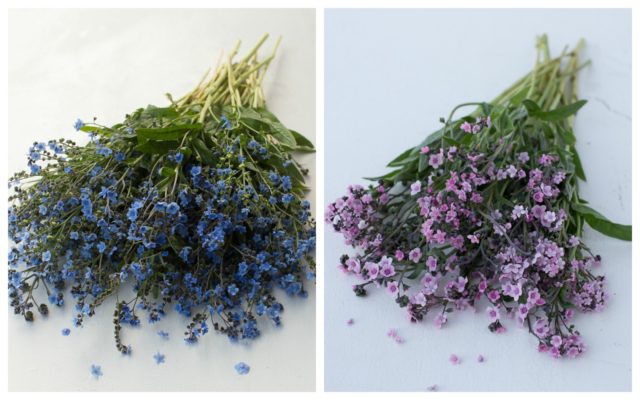 Chinese forget-me-nots (Cynoglossum amabile): This unique crop is worth considering both because of their delicate flowers and the fact that they can be successfully grown as annuals. Best known for their blue hue (like ‘Blue Showers’, above left) they also come in a lovely soft pink color,(‘Mystic Pink’, above right). Be sure to get new seed every year since freshness is vital to good germination with this crop. Also, sow twice as many as you’ll need because germination can be quite irregular. Read my past Flower Focus post on this great flower.
Chinese forget-me-nots (Cynoglossum amabile): This unique crop is worth considering both because of their delicate flowers and the fact that they can be successfully grown as annuals. Best known for their blue hue (like ‘Blue Showers’, above left) they also come in a lovely soft pink color,(‘Mystic Pink’, above right). Be sure to get new seed every year since freshness is vital to good germination with this crop. Also, sow twice as many as you’ll need because germination can be quite irregular. Read my past Flower Focus post on this great flower.
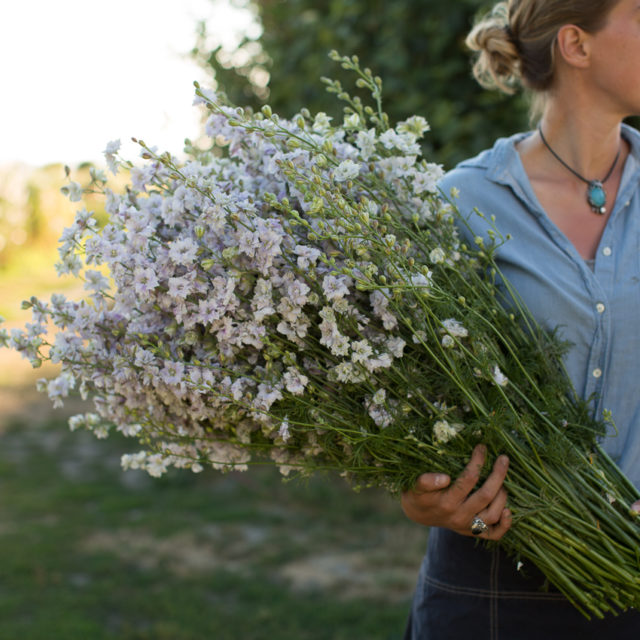
Larkspur: This is of the easiest hardy annual varieties to start from seed. I particularly love ‘Earl Gray’ and our new Summer Skies Mix, a Floret custom color blend. Last summer I fell in love with Larkspur ‘Smokey Eyes’ (pictured above) which has icy pale lavender petals delicately edged with green. I generally direct seed it into the field in the fall and then follow with two rounds of transplants that I start indoors, one in late winter and then one in early spring.
Dianthus: This workhorse of the garden is such an import crop for us that while it isn’t a personal favorite (too bright!) I still plant and pick row after row all season long. The Dianthus ‘Amazon’ and the ‘Sweet’ series are both consistent performers with great stem length and nice sized blooms. Unlike biennial Dianthus, neither require cold temps to set flowers so they can be grown as annuals.
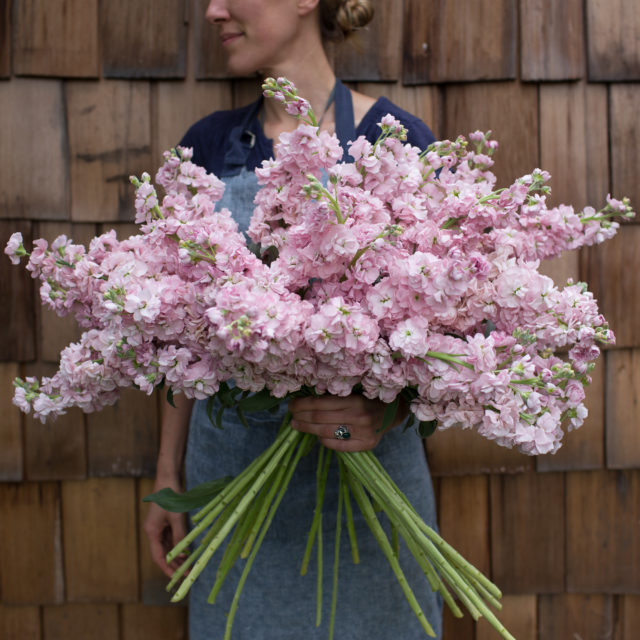
Stock (Matthiola incana): One stem of stock in a bouquet provides a delicious spicy scent that will stop hurried customers dead in their tracks. Stock comes in a wide range of colors and will withstand cold temperatures, making them a great choice for late winter seed starting, even in cooler climates. This is a great flower for small scale flower farmers with season extension structures such as a hoophouse, high tunnel or caterpillar tunnel. Because stock blooms early in a protected structure, it can greatly expand your spring sales window. Stock comes in a wide range of colors, but my favorites include ‘Apricot’ and ‘Malmaison Pink’.
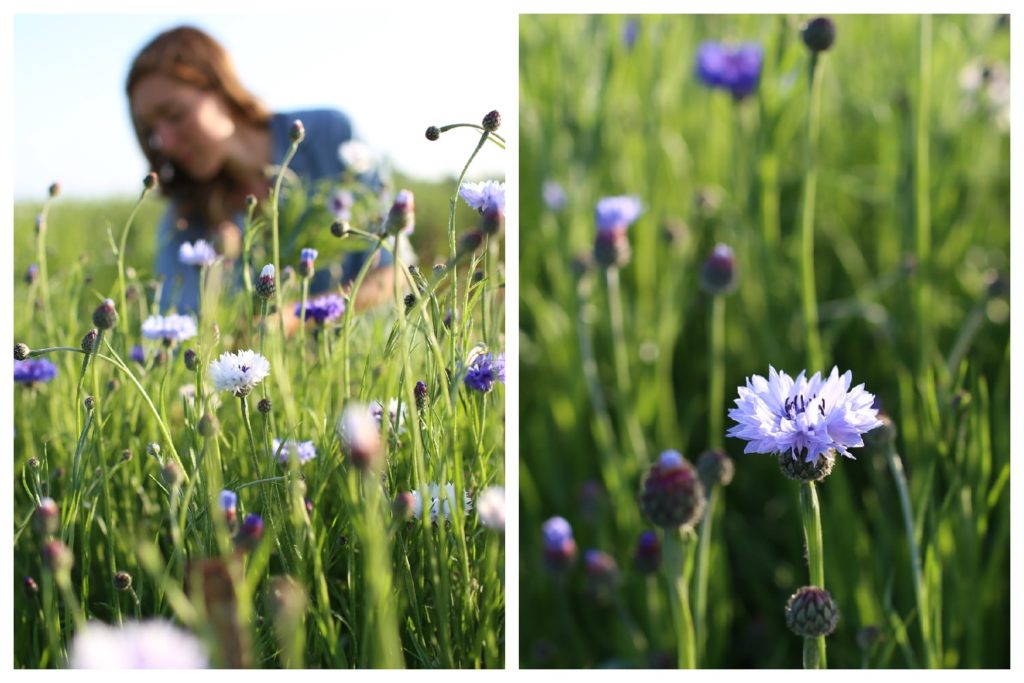 Bachelor’s Buttons (Centaurea cyanus): I have a love-hate relationship with these guys. I love their pretty wildflower blooms in early summer bouquets but I confess that I really hate picking them. I love them. I hate them. Then I love them again because they bloom when most of the rest of the field is still bare. No cutting garden is complete without at least a little patch of Bachelor’s Buttons, especially ‘Classic Fantastic’ or ‘Classic Magic.’
Bachelor’s Buttons (Centaurea cyanus): I have a love-hate relationship with these guys. I love their pretty wildflower blooms in early summer bouquets but I confess that I really hate picking them. I love them. I hate them. Then I love them again because they bloom when most of the rest of the field is still bare. No cutting garden is complete without at least a little patch of Bachelor’s Buttons, especially ‘Classic Fantastic’ or ‘Classic Magic.’
Other wonderful hardy annuals worth mentioning include: Chocolate Lace Flower, Bupleurum, Queen Anne’s Lace and Honeywort.
In you live in a mild climate, many hardy annuals can be direct sown in the garden in late summer/early fall, typically 6-8 weeks prior to your first frost. The plant will form foliage that will overwinter and then send up flower spikes in the spring and bloom much earlier than tender annuals. If you live in a cold climate and have limited space to start seeds indoors, I recommend learning more about winter sowing techniques.
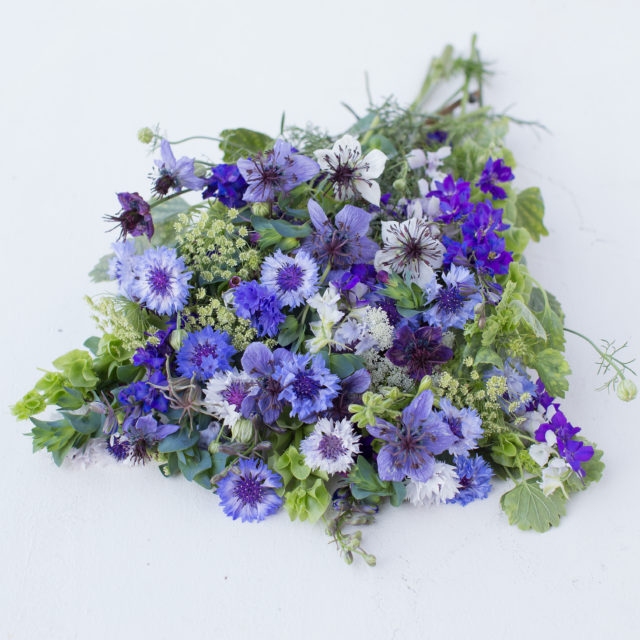
If you love hardy annuals, be sure to snag one of our special Hardy Annual Seed Collections available exclusively in the Floret Shop (but hurry–there are only a few left!). This special collection is packaged in a cute reusable gift tin and includes a great grouping of six easy-to-grow cool summer annuals.
Whether you are ready to start seeding today, or simply looking for inspiration to round out your seed order, be sure to add a few of these favorites into your fields and cutting gardens. After the dark gray days of winter, your spring harvest of beautiful, bountiful blooms will be that much sweeter!
The post Welcome spring with these hardy annual flowers appeared first on Floret Flowers.

If you have access to a greenhouse or an indoor space where you can rig-up some simple grow lights, there are a number of flowers that you can start indoors. For many varieties, you won’t want to start seeds until 6-8 weeks prior to your last frost. (If you are not sure of your area’s frost-free dates, you can enter your zip on Dave’s Garden site which will provide you with an estimate).
There are a number of hardy annual flowers, however, that you can start indoors even earlier, which is great for gardeners itching to get their hands back in the dirt this time of year. Hardy annuals (also called cool season or cold tolerant flowers) generally prefer cooler growing conditions and young plants can tolerate a light frost. Most can be transplanted prior to your last frost, typically as soon as the ground can be worked. Just don’t forget to harden-off your baby plants prior to transplanting.

Love-in-a-Mist (Nigella papillosa): This versatile plant produces both beautiful flowers and unusual pods. Designers drool over the the black pods while I adore the green in mixed bouquets and arrangements. Pods can also be dried and look lovely in fall bouquets. Nigella seeds are most often direct seeded, as they dislike having their roots disturbed, but they can be started early indoors and carefully transplanted into your garden. Because their bloom window is relatively short, I recommend multiple succession sowings of these beauties. A few of my favorites are ‘African bride’ and ‘Cramer’s Plum’ and my Starry Night custom blend (pictured above). Another must-have for the cut flower garden is ‘Transformer’ which features airy, wispy foliage and small, golden yellow flowers.


Snapdragon seeds are pretty easy to germinate and grow, but be forewarned: the seeds are teeny tiny and can make you feel like you are going crosseyed. Sowing them takes a steady hand and a bit of patience, but it is totally worth it when you see the pretty blooms later in the season. Be sure to barely cover them and water them from the bottom (see our Seed Starting 101 photo tutorial for more details) until they are big enough to withstand a heavier overhead drink.

Sweet Peas: These sweet little blooms hold a huge space in my heart and an even bigger space in my garden. My longtime favorites have been ‘Nimbus,’ ‘Mollie Rilstone’ and ‘Erewhon’ (pictured above). After recently expanding our line of specialty sweet pea seeds, my favorites list has grown considerably. New cultivars that stole my heart include ‘Mr. P ‘, ‘Promise’ and ‘Sir Jimmy Shand’. A while back I wrote an in-depth Sweet Pea Roundup post with tons of information on how to grow sweet peas, so be sure to read it for some serious sweet pea inspiration.


Dusty Miller (Cineraria maritima): One of the most productive and unique foliage plants around, this special Dusty Miller features tall, thick stems with large, smooth-edged silver leaves. Seed is sometimes slow to start; bottom watering is recommended until plants emerge. Seedlings do not look silver when very young but color up as they mature.



Larkspur: This is of the easiest hardy annual varieties to start from seed. I particularly love ‘Earl Gray’ and our new Summer Skies Mix, a Floret custom color blend. Last summer I fell in love with Larkspur ‘Smokey Eyes’ (pictured above) which has icy pale lavender petals delicately edged with green. I generally direct seed it into the field in the fall and then follow with two rounds of transplants that I start indoors, one in late winter and then one in early spring.
Dianthus: This workhorse of the garden is such an import crop for us that while it isn’t a personal favorite (too bright!) I still plant and pick row after row all season long. The Dianthus ‘Amazon’ and the ‘Sweet’ series are both consistent performers with great stem length and nice sized blooms. Unlike biennial Dianthus, neither require cold temps to set flowers so they can be grown as annuals.

Stock (Matthiola incana): One stem of stock in a bouquet provides a delicious spicy scent that will stop hurried customers dead in their tracks. Stock comes in a wide range of colors and will withstand cold temperatures, making them a great choice for late winter seed starting, even in cooler climates. This is a great flower for small scale flower farmers with season extension structures such as a hoophouse, high tunnel or caterpillar tunnel. Because stock blooms early in a protected structure, it can greatly expand your spring sales window. Stock comes in a wide range of colors, but my favorites include ‘Apricot’ and ‘Malmaison Pink’.

Other wonderful hardy annuals worth mentioning include: Chocolate Lace Flower, Bupleurum, Queen Anne’s Lace and Honeywort.
In you live in a mild climate, many hardy annuals can be direct sown in the garden in late summer/early fall, typically 6-8 weeks prior to your first frost. The plant will form foliage that will overwinter and then send up flower spikes in the spring and bloom much earlier than tender annuals. If you live in a cold climate and have limited space to start seeds indoors, I recommend learning more about winter sowing techniques.

If you love hardy annuals, be sure to snag one of our special Hardy Annual Seed Collections available exclusively in the Floret Shop (but hurry–there are only a few left!). This special collection is packaged in a cute reusable gift tin and includes a great grouping of six easy-to-grow cool summer annuals.
Whether you are ready to start seeding today, or simply looking for inspiration to round out your seed order, be sure to add a few of these favorites into your fields and cutting gardens. After the dark gray days of winter, your spring harvest of beautiful, bountiful blooms will be that much sweeter!
The post Welcome spring with these hardy annual flowers appeared first on Floret Flowers.
